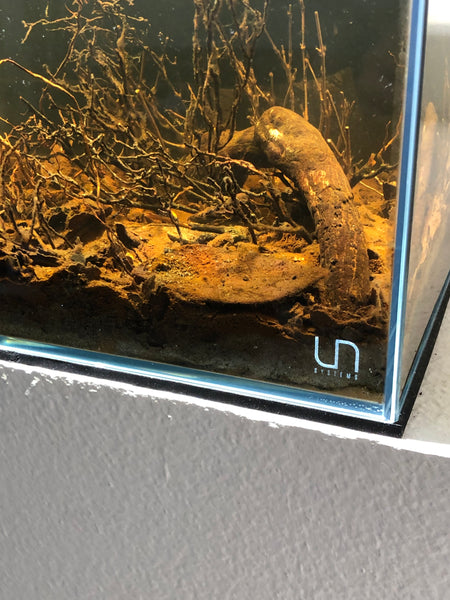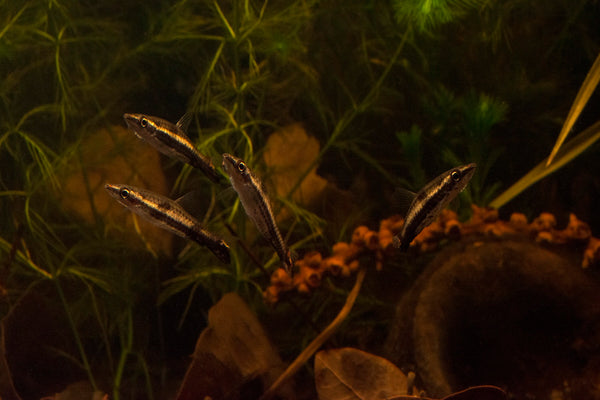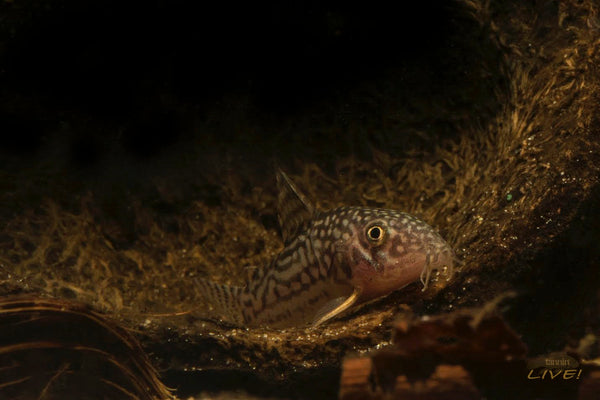- Continue Shopping
- Your Cart is Empty
Stocking "in sequence?" An approach to creating more natural aquariums...
The idea of an "aquarium as a microcosm" is not exactly a new concept. However, the idea of setting up an aquarium to provide more than just a physical "shelter" for its inhabitants; but rather, as a functional habitat designed to create a small ecosystem, and an "in situ" food culturing system intrigues me.

And it kind of goes back to looking at natural aquatic systems.
If you're like me, you spend a little too much time pondering all sorts of arcane aspects of the hobby...Okay, so maybe you're NOT like me, but you have a rather keen interest in the way Nature operates in the wild aquatic systems of the world.

As one who studies a lot of details about some of the habitats from which our fishes come, I can't help but occasionally wonder exactly what it is that brings fishes to a given location or niche within a environment?

Now, the first answer we're likely to proffer is the most apparent...right? I mean, they follow the food!
Fishes tend to move into new areas in search suitable food sources as part of their life cycle. And food sources often become available in habitats such as flooded forest areas after the rains come, when decomposing leaves and botanical materials begin to create (or re-activate, as the case may be) "food webs", attracting ever more complex life forms into the area.

In the case of many blackwater, leaf-litter habitats in South America, for example, the whole food web starts with our old friends, fungi and bacteria. In fact, it's been postulated by scientists that the food web depends primarily on the litter and its associated decomposing fungi. From there, sponges, rotifers, and amoeba arise, and are in turn fed upon by "specialist feeders", such as shrimps (yeah, there ARE shrimps in Amazonia!) and detritivorous fishes.
Then, of course, you also have inesect larvae, particularly chrinomods (i.e.; bloodworms- larval "flies"), and small crustaceans such as Daphnia and the like, which are preyed upon by a host of fishes.

And of course, flooded forest areas are also attractive to fishes which consume the very fruits, plant parts, and terrestrial insects- "allochthonous inputs" -materials imported into an ecosystem from outside of it. As more materials fall from the trees and surrounding dry areas, the greater the abundance of fishes and other aquatic animals which utilize them is found.
These materials will continue to fall into the water and accumulate throughout the period of inundation, maintaining the richness of the habitat as others decompose or are acted on by the organisms residing in the water. And of course, these materials continue to provide foraging for fishes for the duration of this period of time.

So, how does this relate to stocking an aquarium? Is this something we can interpret and utilize in our aquarium designs?
Well, for one thing, I think that you could literally create a sort of "sequence" to stocking various types of fishes based on the stage of "evolution" that your aquarium is in, although the sequence might be a bit different than Nature in some cases. For example, in a more-or-less brand new aquarium, analogous in this case to a newly-inundated forest floor, their might be a lot less in the way of lower life forms, such as fungi and bacteria, until the materials begin breaking down. You'd simply have an aggregation of fresh leaves, twigs, seed pods, soils, etc. in the habitat.
So, if anything, you're likely to see fishes which are much more dependent upon the aforementioned allochthonous input...food from the terrestrial environment. This is a compelling way to stock an aquarium, I think. Especially aquarium systems like ours which make use of these materials en masse.

Right from the start (after cycling, of course!), it would not be unrealistic to add fishes which feed on terrestrial fruits and botanical materials, such as Colossoma, Arowanna, Metynis, etc. Fishes which, for most aquarists of course, are utterly impractical to keep because of their large adult size and/or need for physical space!

(Pacu! Image by Rufus46, used under CC BY-SA 3.0)
Now, a lot of smaller, more "aquarium suited" fishes will also pick at these fruits and seeds, so you're not totally stuck with the big brutes! Interestingly, the consumption and elimination of fruits by fishes is thought to be a major factor in the distribution of many plants in the region.
Do a little research here and you might be quite surprised about who consumes what in these habitats!

More realistically for most aquarists, I'd think that you could easily stock first with fishes like surface-dwelling (or near surface-dwelling) species, like hatchetfishes and some Pencilfishes, which are largely dependent upon terrestrial insects such as flies and ants, in Nature. In other words, they tend to "forage" or "graze" little, and are more opportunistic, taking advantage of careless insects which end up in the water of these newly-inundated environs.
I've read studies where almost 100 species were documented which feed near-exclusively on insects and arthropods from terrestrial sources in these habitats! If you dive a bit deeper than the typical hobbyist writings, and venture into scholarly materials and species descriptions, you'll be fascinated to read about the gut-content analysis of fishes, because they give you a tremendous insight about what to feed in the aquarium!

Continuing on, it's easy to see that, as the environments evolve, so does the fish population. And the possibilities for simulating this in the aquarium are many and interesting!

Later, as materials start to decompose and are acted on by fungi and bacteria, you could conceivably add more of the "grazing" type fishes, such as Plecos, small Corydoras, Headstanders, etc. As the tank ages and breaks in more, this would be analogous to the period of time when micro-crustaceans and aquatic insects are present in greater numbers, and you'd be inclined to see more of the "micropredators" like characins, and ultimately, small cichlids.

Interestingly, scientists have postulated that evolution favored small fishes like characins in these environments, because they are more efficient at capturing small terrestrial insects and spiders in these flooded forests than the larger fishes are!
And it makes a lot of sense, if you look at it strictly from a "density/variety" standpoint- lots of characins call these habitats home!

Then there are detritivores.
The detrivorus fishes remove large quantities of this material from submerged trees, branches, etc. Now, you might be surprised to learn that, in the wild, the gut-content analysis of almost every fish indicates that they consume organic detritus to some extent! And it makes sense...They work with the food sources that are available to them!
At different times of the year, different food sources are easier to obtain.

And, of course, all of the fishes which live in these habitats contribute to the surrounding forests by "recycling" nutrients locked up in the detritus. This is thought by ecologists to be especially important in blackwater inundated forests and meadows in areas like The Pantanal, because of the long periods of inundation and the nutrient-poor soils as a result of the slow decomposition rates.

All of this is actually very easy to replicate, to a certain extent, when stocking our aquaria. Why would you stock in this sort of sequence, when you're likely not relying on decomposing botanicals and leaves and the fungal and microbial life associated with them as your primary food source?
Well, you likely wouldn't be...However, what about the way that the fishes, when introduced at the appropriate "phase" in the tank's life cycle- adapt to the tank? Wouldn't the fishes take advantage of these materials as a supplement to the prepared foods that you're feeding them? Doesn't this impact the fishes' genetic "programming" in some fashion? Can it activate some health benefits, behaviors, etc?

In other words- are they more "comfortable" because of some long-established internal "programming", which provides them with a certain degree of "well-being", if you will, knowing that minimal competition or predators are about? Do they behave differently, acclimate to captivity faster...feed better, have more robust overall health and resistance to disease?
Do these conditions help initiate spawning behavior more readily?

Interesting to ponder, huh?
These are purely speculative, but they can give you some examples of things that we could unlock when we think about how the natural habitats become populated following seasonal and other environmental changes and evolutions. Studying these changes and the conditions which create them is a fascinating educational process that we should all embrace!

The idea of "meeting your tank where it is" and working to stock it and manage it based on what phase of its existence in is fascinating to me. Now, it's not new to add fishes in a sequence or whatever...yet I believe it IS an evolution in the process when we look at stocking in the context of how the environment we're trying to replicate evolves and hosts fishes.

It's sort of another way of looking at many aspects of our aquaria differently- such as providing environmental parameters appropriate for the fishes we like, to aquascaping based on the physical needs of the fishes and the environmental niches from which they come. Not simply "aquascaping" an aquarium, then adding the fishes to compliment it.
I'm thinking about looking at a natural habitat and asking yourself to consider why it looks the way it does, and why the specific fishes which reside there are present. Asking yourself what makes them live there?
 How fishes "follow the food" is just one example of this process.
How fishes "follow the food" is just one example of this process.
There are, of course, other reasons besides food. There may be environmental reasons. Adaptations to tidal influxes (I'm thinking of brackish habitats), the need to seek out specific conditions in which to spawn. Freedom from predators...particularly for juvenile fishes.
Of course, I'm thinking about mangrove estuaries and seagrass beds, where many larval fishes go to feed and grow before heading out to sea or other habitats...but there are numerous other examples in various niches...

So many possibilities. There are so many ways to develop aquariums and stock them based simply on looking at Nature.

Meet your aquarium where it is.
Set the stage for the life forms you want to keep by considering exactly what brings them there in Nature...then observe, enjoy, and learn.
Stay observant. Stay inspired. Stay curious. Stay intrigued. Stay objective. Stay patient...
And Stay Wet.
Scott Fellman
Tannin Aquatics






Scott Fellman
Author